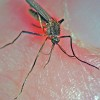Abstract
The black-tailed mosquito is unusual because it overwinters as larvae while most mosquito species overwinter as either adults or eggs. Culiseta melanura is important because of its role in the transmission cycle of eastern equine encephalitis virus and potentially West Nile virus. Because adult female Culiseta melanura primarily take their blood meals from birds, they are responsible for transmitting eastern equine encephalitis virus between birds. This 6-page fact sheet was written by Eva Buckner, Angelique Showman, and C. Roxanne Connelly, and published by the UF Department of Entomology and Nematology, September 2012.
References
Andreadis TG, Anderson JF, Vossbrinck CR. 2001. Mosquito surveillance for West Nile virus in Connecticut, 2000: isolation from Culex pipiens, Cx. restuans, Cx. salinarius, Culiseta melanura. Emerging Infectious Diseases 7: 670-674. https://doi.org/10.3201/eid0704.017413
Apperson CS, Hassan HK, Harrison BA, Savage HM, Aspen SE, Farajollahi A, Crans W, Daniels TJ, Falco RC, Benedict M, Anderson M, McMillen L, Unnasch TR. 2004. Host feeding patterns of established and potential mosquito vectors of West Nile virus in the eastern United States. Vector-Borne and Zoonotic Diseases 4: 71-82. https://doi.org/10.1089/153036604773083013
Barr RA. 1963. Pupae of the genus Culiseta Felt II: descriptions and a key to the North American species. Annals of the Entomological Society of America 56: 324-330. https://doi.org/10.1093/aesa/56.3.324
Bronson CH, Holt TJ. (13 April 2010). Eastern Equine Encephalitis. The Florida Department of Agriculture and Consumer Service, Division of Animal Industry. (15 August 2012)
Carpenter SJ, LaCasse WJ. 1955. Mosquitoes of North America (North of Mexico). University of California Press, Berkeley, California. https://doi.org/10.1525/9780520325098
CDC. (2009). Eastern Equine Encephalitis. Center for Disease Control and Prevention. (15 August 2012).
Clements AN. 1999. The Biology of Mosquitoes, Volume 2. Sensory Reception and Behavior. CABI Publishing, New York.
Crans WJ, Mahmood F. (1998). Culiseta melanura (Coquillett). Mosquito Research & Control. Rutgers. (15 August 2012).
Crans WJ. 2004. A classification system for mosquito life cycles: life cycle types for mosquitoes of the northeastern United States. Journal of Vector Ecology 29: 1-10.
Crans WJ. (2010). Culiseta melanura (Coquillett). Center for Vector Biology. Rutgers. (15 August 2012).
Crans WJ, Mahmood F. (1998). Evidence for a bi-voltine life cycle in Culiseta melanura. Northeastern Mosquito Control Association. (15 August 2012).
Cupp EW, Klingler K, Hassan HK, Vlguers LM, Unnasch TR. 2003. Transmission of eastern equine encephalomyelitis virus in Central Alabama. American Journal of Tropical Medicine and Hygiene 68: 495-500. https://doi.org/10.4269/ajtmh.2003.68.495
Darsie Jr RF, Morris CD. 2000. Keys to the adult females and fourth-instar larvae of the mosquitoes of Florida (Diptera, Culicidae). Technical Bulletin of the Florida Mosquito Control Association. 159 pp.
Darsie Jr RF, Ward RA. 2005. Identification and Geographical Distribution of the Mosquitoes of North America, North of Mexico. University Press of Florida, Gainesville, Florida.
Darsie Jr RF, Tindall EE, Barr AR. 1962. Description of the pupa of Culiseta melanura. Proceedings of the Entomological Society of Washington 3: 167-170.
Godsey MS, Blackmore MS, Panella NA, Burkhalter K, Gottfried K, Halsey LA, Rutledge R, Langevin SA, Gates R, Lamonte KM, Lambert A, Lanciotti RS, Blackmore C, Loyless T, Stark L, Oliveri R, Conti L, Komar N. 2005. West Nile virus epizootiology in the southeastern United States, 2001. Vector-Borne and Zoonotic Diseases 5: 82-89. https://doi.org/10.1089/vbz.2005.5.82
Hickman R, Brown J. (2003). Culiseta melanura biology. Brunswick County Mosquito Control. (15 August 2012).
Horsfall W. 1955. Mosquitoes, Their Bionomics and Relation to Disease. The Ronald Press Company, New York.
ITIS. (2010). Culiseta melanura (Coquillett, 1902). Integrated Taxonomic Information System. (15 August 2012).
Jackman J, Olson J. (2002). Mosquitoes and the diseases they transmit. Texas AgriLife Extension Service, Texas A&M System. (15 August 2012).
King W, Bradley G, Smith C, McDuffie W. 1960. A Handbook of the Mosquitoes of the Southern United States. Agriculture Handbook No. 173. United States Department of Agriculture, Washington D.C.
Mahmood F, Crans WJ. 1998. Effect of temperature on the development of Culiseta melanura (Diptera: Culicidae) and its impact on amplification of eastern equine encephalomyelitis virus in birds. Journal of Medical Entomology 35: 1007-1012. https://doi.org/10.1093/jmedent/35.6.1007
Mattingly PF. 1972. Mosquito eggs XXI Genus Culiseta Felt. Mosquito Systematics Journal 4: 114-127.
Molaei G, Andreadis TG. 2006. Identification of avian-and mammalian-derived bloodmeals in Aedes vexans and Culiseta melanura (Diptera: Culicidae) and its implication for West Nile virus transmission in Connecticut, USA. Journal of Medical Entomology 43: 1088-1093. https://doi.org/10.1093/jmedent/43.5.1088
Molaei G, Oliver J, Andreadis TG, Armstrong PM, Howard JJ. 2006. Molecular identification of blood-meal sources in Culiseta melanura and Culiseta morsitans from an endemic focus of eastern equine encephalitis virus in New York. American Journal of Tropical Medicine and Hygiene 75: 1140-1147. https://doi.org/10.4269/ajtmh.2006.75.1140
Morris CD. (1990). Eastern encephalitis - a fatal mistake. Florida Medical Entomology Laboratory and State of Florida Department of Health. (15 August 2012).
Ortega-Morales AI, Elizondo-Quiroga A, Gonzalez-Villarreal A, Siller-Rodriguez QK, Reyes-Villanueva F, Fernandez-Salas I. 2009. First record of Culiseta melanura in Mexico, with additional Mexican records for Aedes sollicitans. Journal of the American Mosquito Control Association 25: 100-102. https://doi.org/10.2987/08-5774.1
Rusmisel J, Davis V, King E, Turney, P. (1999). The Alameda County Mosquito Abatement District Control Program. Alameda County Mosquito Abatement District, California. (15 August 2012).
Scott TW, Lorenz LH. 1998. Reduction of Culiseta melanura fitness by eastern equine encephalomyelitis virus. American Journal of Tropical Medicine and Hygiene 59: 341-346. https://doi.org/10.4269/ajtmh.1998.59.341
Zacks MA, Paessler S. 2010. Encephalitic alphaviruses. Veterinary Microbiology 140: 281-286. https://doi.org/10.1016/j.vetmic.2009.08.023

